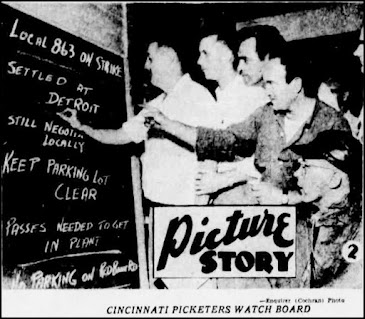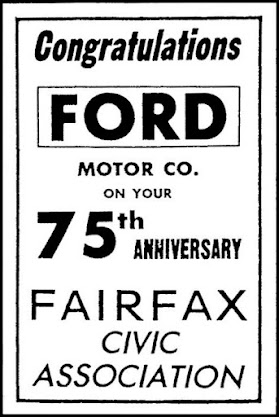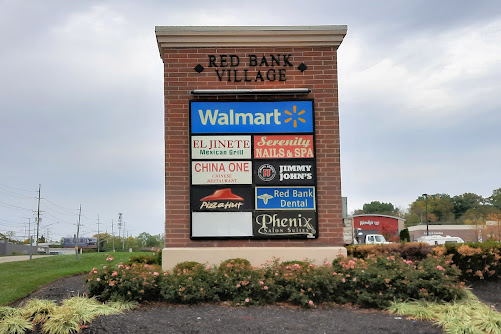No history of Fairfax, Ohio would be complete without discussion
of the Ford Motor Company Automatic Transmission plant. The opening of the
plant played a major role in the organization of the Village of Fairfax (see The Long Road to Incorporation Part One and Part Two), which had been contemplated,
but never accomplished, for decades.
Ford Motor Company Automatic Transmission Division
The Chieftain, Mariemont High School, 1957
The Ford plant was located at the current location of
Walmart and Red Bank Village from 1950 to 1979. In the early part of the 20th
century, the land where the plant was built had been farm land. Ford purchased
the land, which was zoned for heavy industry, from the Pennsylvania Railroad,
which had bought it from the Trailmobile Company.
Ford wasn’t the first automobile manufacturer to attempt
to build a factory in the area. In July 1944, General Motors announced they
would build a plant on Duck Creek Road near Red Bank Road in an unincorporated
area of Columbia Township. The area was not zoned for industry and the
residents in the area did not want an automotive factory in their backyards. GM
promised a “nice, clean plant” that looked more like a school than a factory.
Nevertheless, the residents didn’t want the plant or the “hamburger joints” and
bars they anticipated it would attract. GM wanted resident buy-in for the plant
and did not want litigation. The City of Cincinnati wanted to annex the area
and scrambled to appease both sides, but was unsuccessful. GM did not build the
plant on Duck Creek Road. The Cincinnati Post quoted a Cincinnati civic
leader as saying that they learned that “We’ve got to go out and fight for our
industrial future.”
On November 11, 1949, the Ford Motor Company announced
that they were finalizing the purchase of 55 acres on Red Bank Road. Ground was
broken for the plant within a week. Construction costs were estimated at
$5,000,000 and the plant was expected to employ 1,800 people. The factory would
manufacture automatic transmissions, which would become optional equipment on
Ford vehicles the following summer.
In 1949, 21 new manufacturing operations opened in the
Cincinnati area and 61 others expanded. Some businesses, like American Truss
Company, Nordloh Tile Company, and Nutone opened or relocated their operations
in the same general area as the future Ford plant. However, none of these businesses
could compare in size to the Ford Automatic Transmission plant.
In March 1950, Henry Ford II, 32-year-old president of
Ford Motor Company and grandson of the company’s founder, made his first visit
to Cincinnati. He inspected the construction site with other Ford VIPs. The Cincinnati
Post reported, “He was hatless and he puffed on a cigar as he slogged
through the reddish clay near Red Bank.” Ford was quoted as saying of the area,
“There’s a good labor supply and it is a good, solid town.”
Henry Ford II's first visit to Fairfax
Cincinnati Post, April 20, 1950
The imminent opening of the Ford plant was exciting to
not only those seeking employment, but also to local real estate
agents with home listings in the area. Advertisements for homes for sale in
Fairfax, Mariemont, Madisonville, Madison Place, Hyde Park, Oakley, and Mt.
Washington used the proximity to the new plant as a selling point.
Cincinnati Post, December 28, 1949
Cincinnati Post, August 3, 1950
By the fall of 1950, the plant was 90% complete with
construction being completed by January 1. The plant had around 500,000 square feet
of floor space under a skylighted roof. The assembly line was air conditioned. 60,000
bricks were used to build the 160-foot radial brick chimney. By December, the
plant employed nearly 2,000 people. All hourly workers and 42 of the 46 foremen
were from the Greater Cincinnati area.
As construction of the transmission plant was wrapping up - before a “Ford” sign had even been installed over the building entrance - new
construction began on an addition. The 220,000 square foot addition would handle
defense work, building lubrication pumps for Pratt & Whitney B-36 engines.
Meanwhile, in Fairfax, Ford fever was in full swing.
Potential tax revenue from the plant made previously hesitant Fairfax residents
more comfortable with the idea of incorporating as a village and including the
Ford plant. It was helpful that Ford Motor Company supported Fairfax’s
incorporation bid, rather than having their property annexed to Cincinnati. There
was even talk of changing the community’s name from Fairfax to Fordville.
Cincinnati Post, May 11, 1951
However, the City of Cincinnati wanted to annex the factory site and they certainly weren’t going to concede the area to a yet-to-be-formed
village. The city was “going to fight for [their] industrial future,” as they
vowed after losing the GM plant in 1944. They didn’t want another opportunity
like this to slip through their fingers. A years-long legal battle ensued with
Fairfax prevailing in 1955 and wasting no time in voting to incorporate as a
village. The Red Bank industrial area, though within the Village of Fairfax,
remained in the Cincinnati school district.
"Male Help Wanted" ad, Cincinnati Post, March 24, 1952
As with just about any automotive plant, the amount of
production and number of employees waxed and waned depending on demand, the economy,
production at other plants, and labor actions. In 1953, though, the plant was in
full production mode. 3,500 people were employed at the Fairfax plant, around
25 percent of whom were involved in defense work. There were three shifts and
machinery operated around the clock. The June 15, 1953 Cincinnati Post
described the operations as follows:
Parts move along a 1400-yard-long conveyor at a speed of
four feet per minute. Employes work quickly and precisely, and gradually the
conglomeration of metal begins to look like a transmission.
Inspection and testing are important parts of the whole
process, and finally the transmissions come to the end of the line and are
loaded into steel crates . . . then into a freight car . . . and on their way
to that new Ford or Mercury.
Ford Motor Company Automatic Transmission Division
The Chieftain, Mariemont High School, 1953
On October 20, 1954, Henry Ford II visited the Red Bank
Road plant to commemorate the 1,000,000th transmission coming off
the line. Critics of Ford pointed out that the sign pictured in the photo below
referred to the facility as the “Cincinnati plant” when the company was
fighting annexation to Cincinnati.
Cincinnati Post, October 20, 1954
In June 1955, Ford purchased a 193-acre site in
Sharonville to build a second transmission plant in the Cincinnati area. The
plant would be around three times larger than the Fairfax plant. It opened in
1958 and is still in operation today with around 2,000 employees.
As happens with automobile manufacturers, there were
occasional labor strikes:
Cincinnati Enquirer, June 7, 1955
Cincinnati Times-Star, September 17, 1958
Besides the company's tax contributions, the Ford Motor Company benefited the community in other ways. They
donated ambulances to both the Madison Place and Fairfax Fire Departments. In
1968, an Explorer Scout post specializing in auto mechanics was organized in
cooperation with Ford.
Chief
Kenneth Kuhner and Landis Legg, president of the Fairfax Fire Department
Association, receive an ambulance from Ford officials. Both Kenneth Kuhner and
Landis Legg were employed at the Fairfax Ford plant.
Cincinnati Enquirer, March 2, 1961
In the mid-1960s, Ford’s Fairfax and Sharonville plants
combined were churning out 5,000 automatic transmissions each day. In June
1964, the Fairfax plant celebrated its 5,000,000th transmission. On
January 29, 1965, the two Cincinnati plants announced that a combined 10,000,000
automatic transmissions had rolled off their lines.
Cincinnati Enquirer, July 26, 1964
In the mid-1970s, rumors began circulating that the
Fairfax Automatic Transmission plant could be in line for a major expansion to
produce new five-speed transmissions for smaller cars, adding thousands of new
jobs. Part of the rumored plan involved Ford purchasing the Pogue’s warehouse
on Murray Avenue. Pogue’s reported that they knew nothing of these plans, Ford
vigorously denied the rumors, and there wasn’t, in fact, any expansion of the
Fairfax plant. However, in late 1977 Ford selected a 350-acre site near
Batavia, Ohio for a new $500,000,000 automatic transmission plant.
Cincinnati Post, June 15, 1978
March 11, 1979 was the beginning of the end for the Ford
plant. The company announced that they would close the Fairfax transmission
plant in mid-1980. There was an energy crisis in the United States that began
in the early 1970s and continued throughout the decade. The Fairfax plant was
producing transmissions for larger cars, while consumers were increasingly
interested in smaller, more fuel-efficient cars. The 1,750 jobs at the plant
would be eliminated. Employees with sufficient seniority would be able to
transfer to the Sharonville plant and the remaining employees could transfer to
the new Batavia plant when it opened.
Fairfax officials were not notified of the closing
beforehand, but said they weren’t alarmed. Village Clerk Virmorgan Ziegler said that she wasn’t surprised by the announcement. Vice Mayor James Finan said, "Fairfax
won't go out of business. I don't think they're going to let a facility like
that sit idle. It's a tremendous plant."
Nevertheless, there was concern about the closing
of the plant. Within a few weeks of the announcement, Congressman Willis
Gradison met with Ford officials about the plant closure. Ford then sent a
letter to Gradison that they had "no present intention of abandoning or
disposing of the Fairfax facility." Instead, Ford officials told Gradison that
they had plans to retool the plant, writing that "We have recommended to
our management that we build at Fairfax an advanced version of the new
automatic overdrive transmission we will introduce on 1980 models, and expect
approval of this recommendation to be forthcoming shortly."
Layoffs began at the plant in July 1979 and continued
until October 1979. The village lost approximately $193,000 in earnings tax
with the closure. The plant was never retooled, as Ford led Gradison to
believe, and in January 1982, a Ford spokesman said, "There's just no
justification for bringing that plant back. . . . We have all the transmissions
we need." By the time Ford announced that they were selling the property
in March 1981, only a few security and maintenance employees worked at the
plant site. Ford was hoping to sell the plant for around $12,500,000.
The decision to not rename the village “Fordville” in the
1950s turned out to be an excellent one.
Cincinnati Enquirer, January 7, 1982
By the summer of 1983, Ford still hadn’t sold the plant.
Reportedly, there had been some “bargain basement” offers made on the plant,
but Ford didn’t want to sell for less than the property valuation, which was $11,000,000 at that point.
In the summer of 1983, local developer, Red Bank Centers,
wanted to redevelop the site into a retail and office complex. They partnered
with the Village of Fairfax, which submitted an application for a $4,600,000 Urban Development Action Grant from the U.S. Department of Housing and Urban
Development. However, the plan fell through when the developer was not able to
secure enough commitments from prospective tenants. In February 1985, the Cincinnati
Post wrote "The plant is a daily reminder of lost jobs, broken
promises, dashed hopes." Windows in the plant were broken and weeds grew
in the parking lot.
Finally, Ford sold the property in December 1986 to Red
Bank Distributing, Inc. for $3,250,000. Red Bank Distributing remodeled the
building for warehousing, distribution, and light manufacturing. The facility
was available for lease within a few months. For the next several years, the old Ford plant
housed a number of businesses, such as Galerie au Chocolat and the Matthew 25
Ministries warehouse.
Interior of the former Ford plant, from cincinnatiport.org.
Aerial view of the former Ford plant, looking north to south.
The U.S. Post Office and Cincinnati Sports Club are visible on the left.
From cincinnatiport.org.
The brick chimney, from cincinnatiport.org.
In December 2003, the Clean Ohio Council awarded a $3,000,000 grant for demolition and cleanup of the old Ford plant site. Regency
Centers, LLC bought the property in September 2006. The redevelopment project
would be a joint venture between the Village of Fairfax, Greater Cincinnati
Redevelopment Authority, Regency Centers, Ohio Environmental Protection Agency,
Ohio Department of Development, and W.P. Carey, a real estate investment trust.
Because this property was a former industrial site,
environmental remediation was necessary, including asbestos abatement and
building, soil, and groundwater remediation. Demolition began in January 2005:
.jpg)
.jpg)
Before redevelopment of the site could even begin, rumors
were flying that the anchor would be a Walmart. This caused some concern among
residents in the area, fearing increases in traffic and crime. A group called
Fairfax First formed to oppose Walmart or another big box store opening at the
site. Although undoubtedly there were some Fairfax residents involved in Fairfax
First, it is important to note that the organization was headed by a Hyde
Park resident. The developer and Fairfax Mayor Ted Shannon said that the
concerns were premature, since the Ohio EPA hadn’t yet declared the site free
from contaminants, so no tenants could be signed. Also, Mayor Shannon said that
studies showed that the development would not increase traffic in the
residential area of Fairfax.
Despite the efforts of Fairfax First, construction began
in 2007, ultimately resulting in the Red Bank Village we see today. The first office building at the site opened
in the spring of 2008, ironically, at around the same time the Batavia Ford
plant was winding down production in advance of closure.
Well before the redevelopment began, the village had been
working toward improvements on Red Bank Road. Millions of dollars were spent to
widen and provide flood control for Red Bank. In a September 2, 2007 article,
the Cincinnati Enquirer wrote, "Ten years ago, the . . . Red Bank
Road corridor was little more than a drab conduit to Interstate 71 for
thousands of motorists a day. . . . It was two narrow lanes running past
abandoned industrial and commercial buildings, small stores and offices and
long stretches of weeds."

Cincinnati Enquirer, September 2, 2007
Site of the Ford plant after redevelopment, looking from southwest to
northeast, from cincinnatiport.org.
We now have Walmart and other retail establishments,
office buildings, restaurants, and a police substation where, 25 years ago, we
had an eyesore. It took quite a while, but it was a remarkable comeback for a
village disappointed by the demise of the automotive plant that brought about
its formation.

















.jpg)
.jpg)



